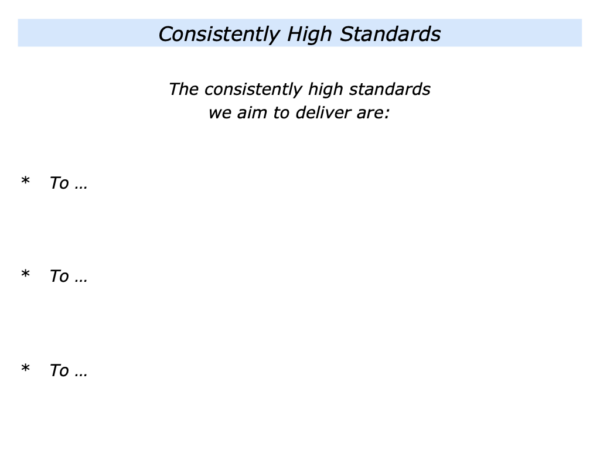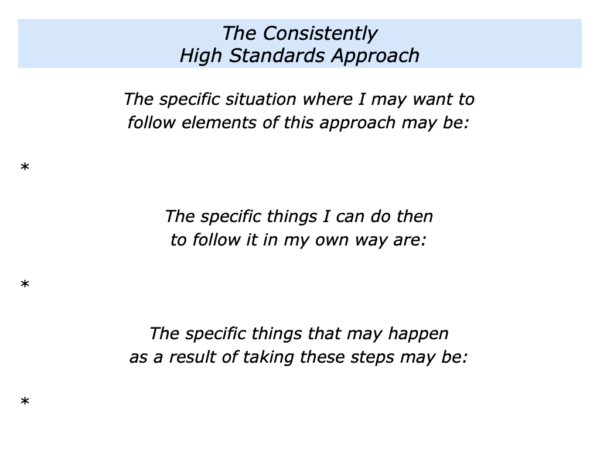
Great workers often follow the delivering consistently high standards approach. They do this whether working as individuals, teams or organisations. They aim to continually do superb work and deliver the goods.
Some workers follow the chaotic approach. They do this as individuals, teams or organisations. They produce work that is inconsistent, poor quality or fails deliver the goods.
Different people follow these approaches in different ways. Let’s explore these themes.
The Consistently High
Standards Approach

When have you encountered people who delivered consistently high standards? This could have been an individual worker, a team or an organisation.
They may have been working as an artist, artisan, counsellor, problem solver or in another role. They may have been people working in a hospice, hotel, sports team, service business or another organisation.
What were the principles the person or people followed? How did they aim to translate these principles into action? What happened as a result of them taking these steps?
Depending on the work they do, different people may follow different principles. But here are some of the most common principles that individuals, teams and organisations may follow to deliver the goods.
Consistently High Standards
The specific things we aim to do to deliver
consistently high standards are these.
* To create a positive environment
To create an encouraging environment and make people feel welcome … To respect and care for people.
* To be professional
To always act in a professional way … To always deliver high quality standards
* To provide superb service
To focus on what people want to achieve … To do our best to help people to achieve their goals.
The specific things people do to translate these standards into action will determine the quality of their work. They aim to deliver these in a way that achieves the desired positive results.
Good organisations continually encourage people to maintain high standards. They often produce success stories, for example, that highlight the specific things that people have done to perform superb work.
They recognise that the quality of their work – their brand – is not what they say it is: it is what their customers experience. They therefore aim keep in touch with their customers:
To clarify their present and future needs;
To clarify what they are doing well – and how they can do more of these things – to fulfil their present and future needs;
To clarify what they can do better – and how – to fulfil their present and future needs.
Good organisations follow the purpose of all service organisations. They aim to use their strengths to do superb work and help their stakeholders to achieve success.
They focus on stability, stimulation and success. They provide stability by following their principles. They then provide a stimulating environment that encourages their people to make their best contributions towards achieving the picture of success.
The Chaotic Approach
Some workers, organisations and governments behave in a chaotic way. They may profess to follow certain principles but they are inconsistent, fail to fulfil their promises and do poor quality work.
Some people follow the chaotic approach in order to cause confusion. They then proclaim themselves to be the only ones who can clean up the mess.
Some organisations create chaos because they fail to describe their purpose or fail to be disciplined when faced by problems. They lurch from problem to problem without producing a clear strategy.
Let’s return to your own work. Looking ahead, can you think of a situation where you may want to follow elements of the consistently high standards approach?
You may aim to do this when working as an individual. Alternatively, you may aim to do this when leading a team or an organisation. How can you follow this approach in your own way?
If you wish, try tackling the exercise on this theme. This invites you to complete the following sentences.







Leave a Reply